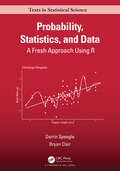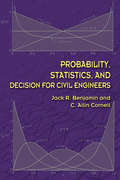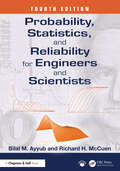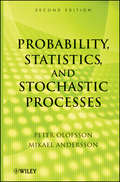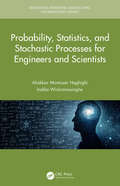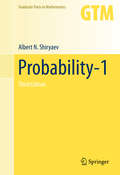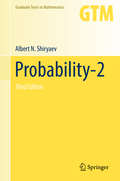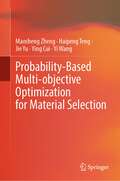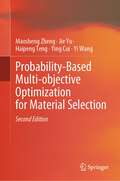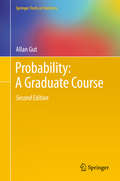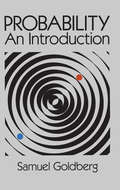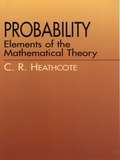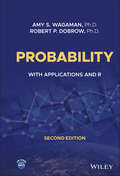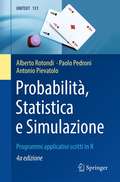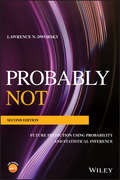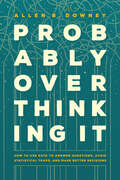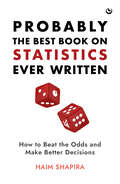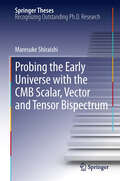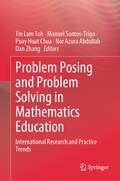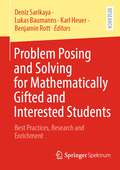- Table View
- List View
Probability, Statistics, and Data: A Fresh Approach Using R (Chapman & Hall/CRC Texts in Statistical Science)
by Darrin Speegle Bryan ClairThis book is a fresh approach to a calculus based, first course in probability and statistics, using R throughout to give a central role to data and simulation. The book introduces probability with Monte Carlo simulation as an essential tool. Simulation makes challenging probability questions quickly accessible and easily understandable. Mathematical approaches are included, using calculus when appropriate, but are always connected to experimental computations. Using R and simulation gives a nuanced understanding of statistical inference. The impact of departure from assumptions in statistical tests is emphasized, quantified using simulations, and demonstrated with real data. The book compares parametric and non-parametric methods through simulation, allowing for a thorough investigation of testing error and power. The text builds R skills from the outset, allowing modern methods of resampling and cross validation to be introduced along with traditional statistical techniques. Fifty-two data sets are included in the complementary R package fosdata. Most of these data sets are from recently published papers, so that you are working with current, real data, which is often large and messy. Two central chapters use powerful tidyverse tools (dplyr, ggplot2, tidyr, stringr) to wrangle data and produce meaningful visualizations. Preliminary versions of the book have been used for five semesters at Saint Louis University, and the majority of the more than 400 exercises have been classroom tested.
Probability, Statistics, and Decision for Civil Engineers (Dover Books on Engineering)
by Jack R Benjamin C. Allin CornellDesigned as a primary text for civil engineering courses, as a supplementary text for courses in other areas, or for self-study by practicing engineers, this text covers the development of decision theory and the applications of probability within the field. Extensive use of examples and illustrations helps readers develop an in-depth appreciation for the theory's applications, which include strength of materials, soil mechanics, construction planning, and water-resource design. A focus on fundamentals includes such subjects as Bayesian statistical decision theory, subjective probability, and utility theory. This makes the material accessible to engineers trained in classical statistics and also provides a brief elementary introduction to probability. The coverage also addresses in detail the methods for analyzing engineering economic decisions in the face of uncertainty. An Appendix of tables makes this volume particularly useful as a reference text.
Probability, Statistics, and Reliability for Engineers and Scientists
by Bilal M. Ayyub Richard H. McCuenVirtually every engineer and scientist must be able to collect, analyze, interpret, and properly use vast arrays of data. This means acquiring a solid foundation in the methods of data analysis and synthesis. Understanding the theoretical aspects is important, but learning to properly apply the theory to real-world problems is essential.The goal of this popular and proven book is to introduce the fundamentals of probability, statistics, reliability, and risk methods to engineers and scientists for the purpose of data and uncertainty analysis and modeling in support of decision-making. The primary objectives to the author’s approach include: (1) introducing probability, statistics, reliability, and risk methods to students and practicing professionals in engineering and the sciences; (2) emphasizing the practical use of these methods; and (3) establishing the limitations, advantages, and disadvantages of the methods. The book was developed with an emphasis on solving real-world technological problems that engineers and scientists are asked to solve as part of their professional responsibilities.Upon graduation, engineers and scientists must have a solid academic foundation in methods of data analysis and synthesis, as the analysis and synthesis of complex systems are common tasks that confront even entry-level professionals.The underlying theory, especially the assumptions central to the methods, is presented, but then the proper application of the theory is presented through realistic examples, often using actual data. Every attempt is made to show that methods of data analysis are not independent of each other. Instead, we show that real-world problem-solving often involves applying many of the methods presented in different chapters.Probability, Statistics, and Reliability for Engineers and Scientists, here in its fourth edition, is a very popular textbook. Ultimately, readers will find its content of great value in problem-solving and decision-making, particularly in practical applications.
Probability, Statistics, and Stochastic Processes
by Peter Olofsson Mikael AnderssonPraise for the First Edition ". . . an excellent textbook . . . well organized and neatly written. " --Mathematical Reviews ". . . amazingly interesting . . . " --Technometrics Thoroughly updated to showcase the interrelationships between probability, statistics, and stochastic processes, Probability, Statistics, and Stochastic Processes, Second Edition prepares readers to collect, analyze, and characterize data in their chosen fields. Beginning with three chapters that develop probability theory and introduce the axioms of probability, random variables, and joint distributions, the book goes on to present limit theorems and simulation. The authors combine a rigorous, calculus-based development of theory with an intuitive approach that appeals to readers' sense of reason and logic. Including more than 400 examples that help illustrate concepts and theory, the Second Edition features new material on statistical inference and a wealth of newly added topics, including: Consistency of point estimators Large sample theory Bootstrap simulation Multiple hypothesis testing Fisher's exact test and Kolmogorov-Smirnov test Martingales, renewal processes, and Brownian motion One-way analysis of variance and the general linear model Extensively class-tested to ensure an accessible presentation, Probability, Statistics, and Stochastic Processes, Second Edition is an excellent book for courses on probability and statistics at the upper-undergraduate level. The book is also an ideal resource for scientists and engineers in the fields of statistics, mathematics, industrial management, and engineering.
Probability, Statistics, and Stochastic Processes for Engineers and Scientists (Mathematical Engineering, Manufacturing, and Management Sciences)
by Aliakbar Montazer Haghighi Indika WickramasingheFeaturing recent advances in the field, this new textbook presents probability and statistics, and their applications in stochastic processes. This book presents key information for understanding the essential aspects of basic probability theory and concepts of reliability as an application. The purpose of this book is to provide an option in this field that combines these areas in one book, balances both theory and practical applications, and also keeps the practitioners in mind. Features Includes numerous examples using current technologies with applications in various fields of study Offers many practical applications of probability in queueing models, all of which are related to the appropriate stochastic processes (continuous time such as waiting time, and fuzzy and discrete time like the classic Gambler’s Ruin Problem) Presents different current topics like probability distributions used in real-world applications of statistics such as climate control and pollution Different types of computer software such as MATLAB®, Minitab, MS Excel, and R as options for illustration, programing and calculation purposes and data analysis Covers reliability and its application in network queues
Probability-1
by Albert N. ShiryaevAdvanced maths students have been waiting for this, the third edition of a text that deals with one of the fundamentals of their field. This book contains a systematic treatment of probability from the ground up, starting with intuitive ideas and gradually developing more sophisticated subjects, such as random walks and the Kalman-Bucy filter. Examples are discussed in detail, and there are a large number of exercises. This third edition contains new problems and exercises, new proofs, expanded material on financial mathematics, financial engineering, and mathematical statistics, and a final chapter on the history of probability theory.
Probability-2: Applications (Graduate Texts in Mathematics #900)
by Albert N. ShiryaevThis textbook is the second volume of a pair that presents the latest English edition of the author’s classic, Probability. Building on the foundations established in the preceding Probability-1, this volume guides the reader on to the theory of random processes. The new edition includes expanded material on financial mathematics and financial engineering; new problems, exercises, and proofs throughout; and a Historical Review charting the development of the mathematical theory of probability. Suitable for an advanced undergraduate or beginning graduate student with a course in probability theory, this volume forms the natural sequel to Probability-1. <P><P> Probability-2 opens with classical results related to sequences and sums of independent random variables, such as the zero–one laws, convergence of series, strong law of large numbers, and the law of the iterated logarithm. The subsequent chapters go on to develop the theory of random processes with discrete time: stationary processes, martingales, and Markov processes. The Historical Review illustrates the growth from intuitive notions of randomness in history through to modern day probability theory and theory of random processes. <P><P> Along with its companion volume, this textbook presents a systematic treatment of probability from the ground up, starting with intuitive ideas and gradually developing more sophisticated subjects, such as random walks, martingales, Markov chains, the measure-theoretic foundations of probability theory, weak convergence of probability measures, and the central limit theorem. Many examples are discussed in detail, and there are a large number of exercises throughout.
Probability-Based Multi-objective Optimization for Material Selection
by Ying Cui Yi Wang Jie Yu Maosheng Zheng Haipeng TengThis book illuminates the fundamental principle and applications of probability-based multi-objective optimization for material selection systematically, in which a brand new concept of preferable probability and its assessment as well as other treatments are introduced by authors for the first time. Hybrids of the new approach with experimental design methodologies, such as response surface methodology, orthogonal experimental design, and uniform experimental design, are all performed; the conditions of the material performance utility with desirable value and robust assessment are included; the discretization treatment of complicated integral in the evaluation is presented. The authors wish this work will cast a brick to attract jade and would make its contributions to relevant fields as a paving stone. This book can be used as a textbook for postgraduate and advanced undergraduate students in material relevant majors, and a reference book for scientists and engineers digging in the related fields.
Probability-Based Multi-objective Optimization for Material Selection
by Ying Cui Yi Wang Jie Yu Maosheng Zheng Haipeng TengThe second edition of this book illuminates the fundamental principle and applications of probability-based multi-objective optimization for material selection in viewpoint of system theory, in which a brand new concept of preferable probability and its assessment as well as other treatments are introduced by authors for the first time. Hybrids of the new approach with experimental design methodologies (response surface methodology, orthogonal experimental design, and uniform experimental design) are all performed; robustness assessment and performance utility with desirable value are included; discretization treatment in the evaluation is presented; fuzzy-based approach and cluster analysis are involved; applications in portfolio investment and shortest path problem are concerned as well. The authors wish this work will cast a brick to attract jade and would make its contributions to relevant fields as a paving stone. It is designed to be used as a textbook for postgraduate and advanced undergraduate students in relevant majors, while also serving as a valuable reference book for scientists and engineers involved in related fields.
Probability: A Graduate Course
by Allan GutLike its predecessor, this book starts from the premise that, rather than being a purely mathematical discipline, probability theory is an intimate companion of statistics. The book starts with the basic tools, and goes on to cover a number of subjects in detail, including chapters on inequalities, characteristic functions and convergence. This is followed by a thorough treatment of the three main subjects in probability theory: the law of large numbers, the central limit theorem, and the law of the iterated logarithm. After a discussion of generalizations and extensions, the book concludes with an extensive chapter on martingales. The new edition is comprehensively updated, including some new material as well as around a dozen new references.
Probability: A Lively Introduction
by Henk TijmsProbability has applications in many areas of modern science, not to mention in our daily life. Its importance as a mathematical discipline cannot be overrated, and it is a fascinating and surprising topic in its own right. This engaging textbook with its easy-to-follow writing style provides a comprehensive, yet concise introduction to the subject. It covers all of the standard material for undergraduate and first-year-graduate-level courses as well as many topics that are usually not found in standard text - such as Bayesian inference, Markov chain Monte Carlo simulation, and Chernoff bounds.
Probability: An Introduction
by Samuel GoldbergExcellent basic text covers set theory, probability theory for finite sample spaces, binomial theorem, probability distributions, means, standard deviations, probability function of binomial distribution, and other key concepts and methods essential to a thorough understanding of probability. Designed for use by math or statistics departments offering a first course in probability. 360 illustrative problems with answers for half. Only high school algebra needed. Chapter bibliographies.
Probability: Elements of the Mathematical Theory
by C. R. HeathcoteDesigned for students studying mathematical statistics and probability after completing a course in calculus and real variables, this text deals with basic notions of probability spaces, random variables, distribution functions and generating functions, as well as joint distributions and the convergence properties of sequences of random variables. Includes worked examples and over 250 exercises with solutions.
Probability: The Classical Limit Theorems
by Henry MckeanProbability theory has been extraordinarily successful at describing a variety of phenomena, from the behaviour of gases to the transmission of messages, and is, besides, a powerful tool with applications throughout mathematics. At its heart are a number of concepts familiar in one guise or another to many: Gauss' bell-shaped curve, the law of averages, and so on, concepts that crop up in so many settings they are in some sense universal. This universality is predicted by probability theory to a remarkable degree. This book explains that theory and investigates its ramifications. Assuming a good working knowledge of basic analysis, real and complex, the author maps out a route from basic probability, via random walks, Brownian motion, the law of large numbers and the central limit theorem, to aspects of ergodic theorems, equilibrium and nonequilibrium statistical mechanics, communication over a noisy channel, and random matrices. Numerous examples and exercises enrich the text.
Probability: Theory and Examples
by Rick DurrettThis book is an introduction to probability theory covering laws of large numbers, central limit theorems, random walks, martingales, Markov chains, ergodic theorems, and Brownian motion. It is a comprehensive treatment concentrating on the results that are the most useful for applications. Its philosophy is that the best way to learn probability is to see it in action, so there are 200 examples and 450 problems.
Probability: Theory and Examples (Cambridge Series in Statistical and Probabilistic Mathematics #49)
by Rick DurrettThis lively introduction to measure-theoretic probability theory covers laws of large numbers, central limit theorems, random walks, martingales, Markov chains, ergodic theorems, and Brownian motion. Concentrating on results that are the most useful for applications, this comprehensive treatment is a rigorous graduate text and reference. Operating under the philosophy that the best way to learn probability is to see it in action, the book contains extended examples that apply the theory to concrete applications. This fifth edition contains a new chapter on multidimensional Brownian motion and its relationship to partial differential equations (PDEs), an advanced topic that is finding new applications. Setting the foundation for this expansion, Chapter 7 now features a proof of Itô's formula. Key exercises that previously were simply proofs left to the reader have been directly inserted into the text as lemmas. The new edition re-instates discussion about the central limit theorem for martingales and stationary sequences.
Probability: With Applications and R
by Robert P. Dobrow Amy S. WagamanDiscover the latest edition of a practical introduction to the theory of probability, complete with R code samples In the newly revised Second Edition of Probability: With Applications and R, distinguished researchers Drs. Robert Dobrow and Amy Wagaman deliver a thorough introduction to the foundations of probability theory. The book includes a host of chapter exercises, examples in R with included code, and well-explained solutions. With new and improved discussions on reproducibility for random numbers and how to set seeds in R, and organizational changes, the new edition will be of use to anyone taking their first probability course within a mathematics, statistics, engineering, or data science program. New exercises and supplemental materials support more engagement with R, and include new code samples to accompany examples in a variety of chapters and sections that didn’t include them in the first edition. The new edition also includes for the first time: A thorough discussion of reproducibility in the context of generating random numbers Revised sections and exercises on conditioning, and a renewed description of specifying PMFs and PDFs Substantial organizational changes to improve the flow of the material Additional descriptions and supplemental examples to the bivariate sections to assist students with a limited understanding of calculus Perfect for upper-level undergraduate students in a first course on probability theory, Probability: With Applications and R is also ideal for researchers seeking to learn probability from the ground up or those self-studying probability for the purpose of taking advanced coursework or preparing for actuarial exams.
Probabilità, Statistica e Simulazione: Programmi applicativi scritti in R (UNITEXT #131)
by Alberto Rotondi Paolo Pedroni Antonio PievatoloIl libro contiene in forma compatta il programma svolto negli insegnamenti introduttivi di Statistica e tratta alcuni argomenti indispensabili per l'attività di ricerca, come le tecniche di simulazione Monte Carlo, i metodi di inferenza statistica, di best fit e di analisi dei dati di laboratorio. Gli argomenti vengono sviluppati partendo dai fondamenti, evidenziandone gli aspetti applicativi, fino alla descrizione dettagliata di molti casi di particolare rilevanza in ambito scientifico e tecnico. Il testo è rivolto agli studenti universitari dei corsi ad indirizzo scientifico e a tutti quei ricercatori che devono risolvere problemi concreti che coinvolgono l’analisi dei dati e le tecniche di simulazione. In questa edizione, completamente rivista e corretta, sono stati aggiunti alcuni importanti argomenti sul test d’ipotesi (a cui è stato dedicato un capitolo interamente nuovo) e sul trattamento degli errori sistematici. Per la prima volta è stato adottato il software R, con una ricca libreria di programmi originali accessibile al lettore.
Probably Not: Future Prediction Using Probability and Statistical Inference
by Lawrence N. DworskyA revised edition that explores random numbers, probability, and statistical inference at an introductory mathematical level Written in an engaging and entertaining manner, the revised and updated second edition of Probably Not continues to offer an informative guide to probability and prediction. The expanded second edition contains problem and solution sets. In addition, the book’s illustrative examples reveal how we are living in a statistical world, what we can expect, what we really know based upon the information at hand and explains when we only think we know something. The author introduces the principles of probability and explains probability distribution functions. The book covers combined and conditional probabilities and contains a new section on Bayes Theorem and Bayesian Statistics, which features some simple examples including the Presecutor’s Paradox, and Bayesian vs. Frequentist thinking about statistics. New to this edition is a chapter on Benford’s Law that explores measuring the compliance and financial fraud detection using Benford’s Law. This book: Contains relevant mathematics and examples that demonstrate how to use the concepts presented Features a new chapter on Benford’s Law that explains why we find Benford’s law upheld in so many, but not all, natural situations Presents updated Life insurance tables Contains updates on the Gantt Chart example that further develops the discussion of random events Offers a companion site featuring solutions to the problem sets within the book Written for mathematics and statistics students and professionals, the updated edition of Probably Not: Future Prediction Using Probability and Statistical Inference, Second Edition combines the mathematics of probability with real-world examples. LAWRENCE N. DWORSKY, PhD, is a retired Vice President of the Technical Staff and Director of Motorola’s Components Research Laboratory in Schaumburg, Illinois, USA. He is the author of Introduction to Numerical Electrostatics Using MATLAB from Wiley.
Probably Overthinking It: How to Use Data to Answer Questions, Avoid Statistical Traps, and Make Better Decisions
by Allen B. DowneyAn essential guide to the ways data can improve decision making. Statistics are everywhere: in news reports, at the doctor’s office, and in every sort of forecast, from the stock market to the weather. Blogger, teacher, and computer scientist Allen B. Downey knows well that people have an innate ability both to understand statistics and to be fooled by them. As he makes clear in this accessible introduction to statistical thinking, the stakes are big. Simple misunderstandings have led to incorrect medical prognoses, underestimated the likelihood of large earthquakes, hindered social justice efforts, and resulted in dubious policy decisions. There are right and wrong ways to look at numbers, and Downey will help you see which are which. Probably Overthinking It uses real data to delve into real examples with real consequences, drawing on cases from health campaigns, political movements, chess rankings, and more. He lays out common pitfalls—like the base rate fallacy, length-biased sampling, and Simpson’s paradox—and shines a light on what we learn when we interpret data correctly, and what goes wrong when we don’t. Using data visualizations instead of equations, he builds understanding from the basics to help you recognize errors, whether in your own thinking or in media reports. Even if you have never studied statistics—or if you have and forgot everything you learned—this book will offer new insight into the methods and measurements that help us understand the world.
Probably Overthinking It: How to Use Data to Answer Questions, Avoid Statistical Traps, and Make Better Decisions
by Allen B. Downey&“A delightful exposition of commonly-encountered statistical fallacies and paradoxes and why they matter.&” —Samuel H. Preston, coauthor of Demography: Measuring and Modeling Population Processes An essential guide to the ways data can improve decision making. Statistics are everywhere: in news reports, at the doctor&’s office, and in every sort of forecast, from the stock market to the weather. Allen B. Downey knows well that people have an innate ability both to understand statistics and to be fooled by them. As he makes clear in this accessible introduction to statistical thinking, the stakes are big. Simple misunderstandings have led to incorrect medical prognoses, underestimated the likelihood of earthquakes, hindered social justice efforts, and resulted in dubious policy decisions. There are right and wrong ways to look at numbers, and Downey will help you see which are which. Probably Overthinking It uses real data to delve into real examples, drawing on cases from health campaigns, political movements, and more, shining a light on what we learn when we interpret data correctly, and what goes wrong when we don&’t. Even if you have never studied statistics—or if you have and forgot everything you learned—this book will offer new insight into the methods and measurements that help us understand the world. &“Downey&’s pure love for the subject shines through abundantly, as does his social conscience and belief in the importance of statistical methods to illuminate the greatest, most challenging issues of our time.&” —Aubrey Clayton, author of Bernoulli&’s Fallacy: Statistical Illogic and the Crisis of Modern Science &“[Downey&’s] style is lively and designed to appeal to the curious reader.&” —Choice
Probably the Best Book on Statistics Ever Written: How to Beat the Odds and Make Better Decisions
by Haim ShapiraTaking an amusing and digestible look at the usually dry world of probability and statistics, this is the ultimate guide to how you can incorporate them into everyday life, from one of the world's most sought-after experts in game theory. This is the only book you need to become a statistics whizz! Numbers are everywhere – food packaging, weather forecasts, social media, adverts, and more. You can&’t escape them. But you can learn to understand them – and avoid being fooled! This book breaks down the key fundamentals in statistics in a fun and accessible way so that you can understand the numbers that occupy your life. • Make sense of sports stats – discover who is the greatest scorer of all time • Learn to interpret scientific studies and how they&’re reported in the media so you&’re never misled again • Discover tips and tricks to make you a more successful gambler • Explore what role stats has to play in flat-earth conspiracy arguments • Read about misunderstood probabilities in the Sally Clarke and OJ Simpson trials With easy-to-follow explanations, tables, graphs, and real-life examples, this book helps you evaluate your options, calculate your chances of success, and make better decisions.
Probing the Early Universe with the CMB Scalar, Vector and Tensor Bispectrum
by Maresuke ShiraishiThe non-Gaussianity in the primordial density fluctuations is a key feature to clarify the early Universe and it has been probed with the Cosmic Microwave Background (CMB) bispectrum. In recent years, we have treated the novel-type CMB bispectra, which originate from the vector- and tensor-mode perturbations and include the violation of the rotational or parity invariance. On the basis of our current works, this thesis provides the general formalism for the CMB bispectrum sourced by the non-Gaussianity in the scalar, vector and tensor-mode perturbations. Applying this formalism, we calculate the CMB bispectra from the two scalars and a graviton correlation and primordial magnetic fields, and then outline new constraints on these magnitudes. Furthermore, this formalism can be easily extended to the cases where the rotational or parity invariance is broken. We also compute the CMB bispectra from the scalar-mode non-Gaussianities with a preferred direction and the tensor-mode non-Gaussianities induced by the parity-violating Weyl cubic terms. Here, we show that these bispectra include unique signals, which any symmetry-invariant models can never produce.
Problem Posing and Problem Solving in Mathematics Education: International Research and Practice Trends
by Dan Zhang Manuel Santos-Trigo Tin Lam Toh Puay Huat Chua Nor Azura AbdullahThis book presents both theoretical and empirical contributions from a global perspective on problem solving and posing (PS/PP) and their application, in relation to the teaching and learning of mathematics in schools. The chapters are derived from selected presentations in the PS/PP Topical Study Group in ICME14. Although mathematical problem posing is a much younger field of inquiry in mathematics education, this topic has grown rapidly. The mathematics curriculum frameworks in many parts of the world have incorporated problem posing as an instructional focus, building on problem solving as its foundation. The juxtaposition of problem solving and problem posing in mathematics presented in this book addresses the needs of the mathematics education research and practice communities at the present day. In particular, this book aims to address the three key points: to present an overview of research and development regarding students’ mathematical problem solving and posing; to discuss new trends and developments in research and practice on these topics; and to provide insight into the future trends of mathematical problem solving and posing.
Problem Posing and Solving for Mathematically Gifted and Interested Students: Best Practices, Research and Enrichment
by Benjamin Rott Deniz Sarikaya Lukas Baumanns Karl HeuerMathematics and mathematics education research have an ongoing interest in improving our understanding of mathematical problem posing and solving. This book focuses on problem posing in a context of mathematical giftedness. The contributions particularly address where such problems come from, what properties they should have, and which differences between school mathematics and more complex kinds of mathematics exist. These perspectives are examined internationally, allowing for cross-national insights.
